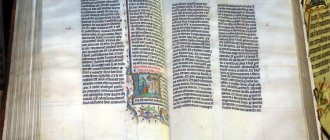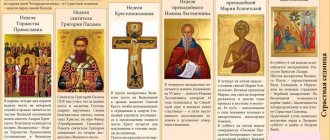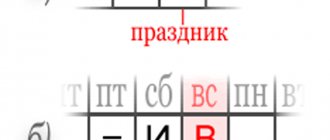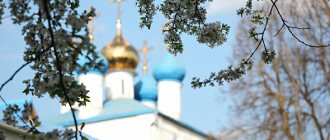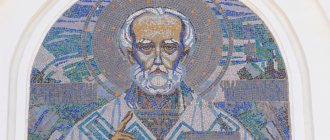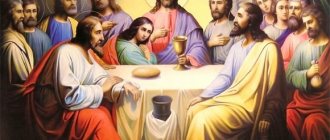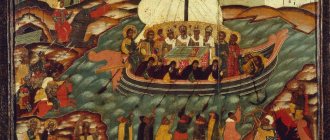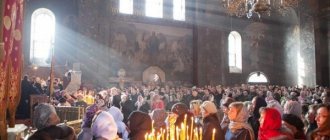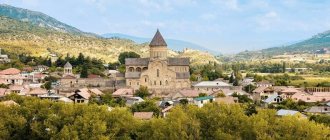Definition of Matins
Matins is a church service, which, according to the Charter of our church, should be performed in the very early morning, even before sunrise. The whole essence of Matins is gratitude to God for the past and experienced night, for the coming of a new day in our lives.
Matins is one of the services of the daily cycle in the Orthodox Church
If you look at the structure of daily worship, then Matins is part of the so-called all-night vigil. Initially, among the first Christians, the all-night vigil was celebrated at night, because it was often dangerous or even impossible to organize a service during the day. In the modern Church, the all-night vigil is very rarely served entirely at night; it is broken into parts. But the name has been assigned to this service since ancient times.
Matins is the second part of the All-Night Vigil, which follows Vespers. In its content, it correlates us with the times of the Old Testament, when Christ just came into our world to save each of us, for which he defeated death and was resurrected.
Important! Today, Matins is served at the evening service, which is established in each church in the evening, on the eve of holidays, Sundays and any other days when there is Liturgy.
It is not difficult to determine the beginning of Matins - it begins with the reading of the Six Psalms, when all the lamps in the temple are turned off and only the lit lamps are left burning. This is a very touching and memorable moment of the entire service - the entire temple, illuminated only by the soft light of the lamps, is immersed in common prayer.
Matins, its history, rites and spiritual meaning
Original: https://www.eparhia-saratov.ru/Articles/voskhodu-solnca-i-solnca
We are talking with the candidate of theology, head of the biblical department of the Saratov Theological Seminary, Alexei Kashkin, about Orthodox worship. The topic of our conversation today is Matins, its history, rites and spiritual meaning.
— Every living thing tends to respond to the sunrise, and humans are no exception; but the person is reasonable and spiritual. Morning worship probably came into our church life from ancient times?
— Yes, the transition from night to day has been sanctified by worship since Old Testament times, and among Christians Matins appeared in the first centuries of Christianity. Of course, initially its rite was different from today: from that time only individual psalms remained in our rite, for example, Psalm 62, sung by David in the Judean desert: O God, my God, my soul thirsts for You in the morning. Since ancient times, the best spiritual poets and hymn writers - for example, Roman the Sweet Singer - composed chants for Matins. Today, Matins can be called the main divine service of the daily circle (remember that the Divine Liturgy is not included in the daily circle): it is the longest, and it is the one that accounts for the maximum number of festive chants. The Studite and Jerusalem Rules established Matins in its modern form, and since the advent of the Jerusalem Rule, the Church on especially solemn days - Sundays, great holidays and days of remembrance of the most revered saints - has performed it as part of the All-Night Vigil, that is, in the evening.
— At what point in the All-Night Vigil does Matins begin?
— The exclamation “The blessing of the Lord be upon you” dates back to Vespers. The beginning of Matins is the angelic doxology followed by the reading of the Six Psalms. Why are these six psalms - the 3rd, 37th, 62nd, 87th, 102nd, 142nd - read precisely at the beginning of Matins? The first part of the all-night vigil, Vespers, is a symbolic image of the Old Testament story, and Matins symbolizes the New Testament, the coming of the Savior into the world. The Six Psalms is a transition to the New Testament. It reflects the unhappy, sinful state of fallen humanity, which has already learned about the birth of the Infant of God (that is why the Six Psalms is preceded by the angelic praise to Him (Luke 2:14 ): Glory to God in the highest, and on earth peace), but who have not yet heard the gospel message in all its completeness. The Six Psalms, as the Typikon says, is a conversation between the soul and God. A man reviews his life, asks the Lord to forgive his sins, to deliver him from his distress. For a person, the connection between his troubles and his own sins is obvious, and he, suffering, turns his prayerful cry of repentance to God. The Six Psalms is intended to return us from heaven to earth: from the joy of the holiday, which permeates Vespers, to the real picture of our unworthiness. We will return to joy a little later - during the polyeleos.
— What awaits us after the Six Psalms?
- Peaceful litany (“In peace let us pray to the Lord...”), the same as at Vespers. And then God the Lord sang and appeared to us (Ps. 117 :27). These words from the psalm symbolically indicate the Coming of the Savior into the world. Next, troparia are sung for the holiday that has already arrived. And then the kathismas are read, that is, certain parts of the Psalter. As already said, Matins symbolically depicts the New Testament time - the time after the Coming of Christ; and the psalms are Old Testament texts. Therefore, the moment of reading the Psalter before the polyeleos can be perceived as preparatory and partly repentant.
- What is polyeleos?
- This is the most solemn part of not everyday, but specifically festive matins, that is, the one that in our practice is performed on the eve of holidays and on Saturday evening. At this time, the temple is illuminated as much as possible; censing of the entire temple is performed; The psalms that are sung in polyeleos glorify and praise the Lord. The composition of the polyeleos includes psalms 134 (Praise the name of the Lord, praise, servants, the Lord) and 135, in which the refrain or refrain is repeated many times, as if his mercy endures forever. The Greek word for mercy is eleos. And “poly” means “many”, hence the word itself - polyeleos.
Then the celebration of the holiday is heard in the temple. On Saturdays, Sunday is glorified - the day when we remember the Resurrection of Christ - and Sunday chants are added to the polyeleos. If we clarify the terminology, then only these two psalms - the 134th and 135th - should be called polyeleos, but it would not be a big mistake if we call the entire most solemn and joyful part of Matins - up to the canon - polyeleos. That is, exactly the part that introduces us to the event of the holiday. The prokeimenon, the stichera of the holiday, sounds here; The Gospel of the holiday is read, on Saturdays - those pages that tell about the Resurrection of Christ. This is the heart of morning worship. And then the litia prayer is read (remember that the litia is an enhanced prayer at Vespers) “Save, O God, Thy people,” which lists the names of the most revered saints. Since 2011 - since the establishment of the celebration of the Cathedral of Saratov Saints - we, Saratov residents, have heard in our churches the names of those who are included in the Cathedral.
- Now about the canon of Matins...
— The canon is a complex hymnographic work, consisting in our practice of eight songs. Its content is a diverse understanding of the celebrated event; it shows the holiday event in different semantic aspects. The canon reflects many theological ideas associated with the celebrated event. That is why the canon can be called the central chant of the holiday.
Many canons were written by outstanding church authors of the 7th-9th centuries and to this day occupy a worthy place in our worship. The canon of Matins must be treated with the utmost care: unfortunately, in our practice, during the canon, anointing is performed, which distracts many parishioners and prevents them from perceiving the words of the canon.
— Many of our parishioners have a certain consumerist or even magical attitude towards this action. A person who does not have the time or desire to stand the entire all-night vigil strives to run to the anointing alone and then go about his business. Is there any point in such a run?
— The rite of anointing at Matins is old, it has been known since the 13th–14th centuries. True, then it was performed not during, but after Matins. As has already been said, Matins was then different, its most solemn moment, the end was precisely the peak, and it was followed by anointing. In this case, the oil was taken from the lamp burning in front of the icon of the holiday. Thus, it was a kind of seal, introducing a person to the triumph of the Church. Nowadays, with us, the anointing is also performed after the most solemn part of Matins, but not at the end: it is combined with the kissing of the Gospel and the icon of the holiday, which in the old days was prescribed to be done after the magnification. In this case, the oil used is the one that was consecrated at Vespers, although the meaning of consecration at Vespers is precisely the consecration of food (remember: “Bless this bread, the wheat, the wine and the oil...”). But, as in past centuries, this ritual introduces Christians to joy and celebration. There is no additional meaning in anointing. From this point of view, ignoring the holiday service and running into church for the anointing alone is an action devoid of meaning. Anointing with oil at Matins is not a sacrament; oil does not have a healing effect. Our trouble, probably, is that we do not have genuine attention to worship, to prayer, to the meanings that it contains, and therefore our consciousness grasps at the action, at something material - this is easier to perceive.
“And yet we are waiting for more than just the anointing. We always wait with excitement when they sing “The Most Honest Cherub” and ring the bells...
— The song of the Most Holy Theotokos “My soul magnifies the Lord” with the refrain “The most honorable cherub and the most glorious without comparison the seraphim” is, unfortunately, the only one of the nine biblical songs that were previously sung at Matins and which are now sung only during Great Lent. Perhaps she was singled out from everyone because the Mother of God is revered much more than all the righteous people of the Old Testament. “The most honorable cherub...” is actually the irmos of Cosmas of Mayum, written for the ninth song of the Canon of Good Friday, but he began to live his own life, separate from the service of Holy Week, and is now sung with the Song of the Mother of God. This song during the morning service is evidence of a special, intense veneration of the Mother of God; During Great Lent it is sung with prostrations to the ground.
— We have approached the most joyful moment of Matins: the priest’s exclamation “Glory to Thee, who showed us the light” and the Great Doxology...
- This is, in fact, the second peak of Matins after the polyeleos. The great doxology “Glory to God in the highest, and on earth peace, and good will toward men” is a very ancient text, approximately the 4th century, it is composed of many biblical verses: I will bless Thee every day (Ps. 144 :2), blessed art thou , Lord, teach me by Your justification (Ps. 119 :12). A very beautiful chant, a solemn moment. As during the polyeleos, the temple is illuminated as much as possible—the chandelier is turned on. The exclamation “Glory to You, who showed us the light” is gratitude to God for the coming of a new day.
At the end of Matins, before dismissal, we hear the chant “Confirm, O God, the holy Orthodox faith...”. In the old days, it was a multi-year period proclaimed to the sovereign, patriarch, and bishop. Letting go is a short prayer beginning with the words “Christ our true God...”. This is the result of the entire service, the line that is drawn under it. And this is a pastoral blessing to believers after the service.
Newspaper "Orthodox Faith" No. 22 (522)
Alexey Kashkin
What is the Six Psalms after Matins?
Reading the Old Testament psalms shows the sorrow of the human soul over its fallen sinful state, languor in anticipation of the coming of the Savior, which filled the times of the Old Testament.
Interesting! To ensure that the reading of the Six Psalms is not too gloomy, the mood of the psalms changes: both mournful psalms and joyful psalms filled with the Glory of the coming of Christ are read.
A special attitude towards the Six Psalms is expressed in the fact that during this reading all those praying are supposed to stand, but walking around the temple, lighting candles, or performing any other actions is forbidden. Of course, if a person, due to his weakness, cannot withstand this part of the service, he can sit down.
The Six Psalms are read at every morning, with the exception of the days of Bright Week.
The Six Psalms are read in two parts: after the first three psalms, the priest stands in front of the Royal Doors and begins reading special morning prayers, in which he asks for blessings for himself and his flock for the new day, and thanks for the past night. Coming out of the altar, the priest symbolically personifies Christ as the promised Savior of all mankind.
Read about the services:
- Divine service for Christmas
- Why should you go to temple?
- What is a prayer service and how to order it
Litany and kathismas
At the end of the Six Psalms, the deacon begins to proclaim the great litany, after which the praise of the Lord is proclaimed - “God is the Lord and has appeared to us, blessed is He who comes in the name of the Lord.” These words can often be heard in the temple, they remind us of those times when the Lord was in our world, how he entered Jerusalem in glory, where he suffered martyrdom.
Important! Immediately after the litany, troparia are sung in honor of the feast of the given day or saint, whose memory is now being celebrated.
The next step in the sequence of Matins is the reading of the Psalter according to kathismas. Kathisma is several psalms combined into one part. Their reading, like the reading of the Six Psalms, is aimed at remembering our sinfulness and the need for repentance. At the same time, in the psalms we see hope that with God's help we can overcome the corrupting effects of sins. While reading the kathismas in the temple, you are allowed to sit down, and after they are finished, all the lamps are turned on.
Lamp prayers
The prayers read by the priest while singing the opening psalm are called “lamp prayers”, εύχαι του λυχνακοΰ, i.e., vespers prayers (vespers were called το λυχνικόν, “lamp”, already in the 4th century), since these are almost all the prayers of the priest at vespers, and in ancient times they were distributed at different moments of this service. They are assigned the sacred number 7, which corresponds to the 7 days of creation and Providence, sung when reading them; at Matins, corresponding to the greater length and importance of this service, similar prayers are also assigned a sacred number, but 12. In terms of content, neither each individual prayer of the lamp, nor, moreover, the entire series of them, do not represent anything systematic. Nevertheless, each subsequent prayer, directing attention to a new side in the being of God, adds something to the requests of the previous ones. The 1st, appealing to the mercy and long-suffering of God, these basic properties of Him, as an introductory one, asks first of all to hear our prayer, to guide us in general on the path of God and to impart a joyful feeling of the fear of God; the prayer has a final doxology, identical with the exclamation of the great litany. The 2nd and 3rd prayers are of a repentant nature, and one also asks for spiritual enlightenment and a sinless rest of the day, and the other for the fulfillment of all our petitions, full of hope in God, for giving us not only the fear of God (1- I say), but also love for Him; The prayers conclude with exclamations of the 2nd and 3rd litanies of (small) Vespers. The 4th prayer is of a joyful nature - remembering the angelic praises of God, asks to merge with them our praise now and in eternity; as a final doxology, she again shouts the great litany.
It must be because it was read at the ancient Vespers after the Lord cried, and at this place of the ancient Vespers there was a great litany; before the Lord cried there were 3 antiphons with small litanies (see Kekeyaidze K, archpriest Liturgical cargo memorial, 144).
The 5th prayer, paying attention to the Providence of God, not shaken by our sins, asks for preservation from them for the rest of the day and throughout our lives; has a doxology almost identical to the exclamation of the litany before the canon at Matins and with the liturgical exclamation before communion. The 6th prayer, paying attention not only to the Providence of God (cf. mol. 5), testifying to the greatness, inscrutability and goodness of God, but also to the Kingdom promised to us, again (cf. mol. 2 and 5) asks for a sinless remnant day. The 7th is exceptional in its content and size among other prayers of light. Directing our gaze to the greatness, immortality and luminosity of God and surveying the contents of not only Vespers (expressions are borrowed from Ps. 103 and 140), but also Compline (there is an expression from Ps. 90 and the last prayer of Compline), it contains only one petition for the sinless and happy evening, night and morning (already).
The prayers of light, read now on the opening psalm, are older than the use of this psalm at Vespers, and therefore initially they were not associated with this psalm, but with the so-called antiphons of Vespers, that is, with psalms sung verse by verse with special refrains similar to refrains to the current liturgical antiphons: “Save us the Son of God through the prayers of the Mother of God,” etc. In some ancient Euchologies (c. XIII century), the evening prayers are inscribed “prayer of the 1st antiphon,” “prayer of the 2nd antiphon.” Such inscriptions are found even in lists of the 16th century. However, in the most ancient, now known, Euchologies of the 8th-10th centuries. Evening prayers are simply numbered, which perhaps indicates that even then they were taken from their previous places and dedicated to one moment of Vespers.
This is especially evident from the fact that the last prayer of Vespers of the 8th antiphon in these Euchologies (VIII-X centuries) is inscribed “I cried to the Lord”: 140 ps. never occupied the last place at Vespers, but on the contrary, from ancient times, already from the era of the Apostolic Constitutions, he was at the beginning of it.
The simplest and, probably, the oldest practice for these prayers is represented, apparently, from the currently known monuments, despite the relatively late era of the manuscript (XVI century), the Georgian Euchologium of the Tiflis Church Museum, indicating in the section under the title: “Sunday prayers of antiphons and vespers, when the priest puts on his vestments and there is a vigil,” the following order of evening prayers is significantly different from ours.
Giving a detailed rite of Vespers, this Euchologius does not mention the opening psalm, but begins by naming the first three of the current prayers, calling them the prayers of the 1st, 2nd and 3rd antiphons and assigning after each of them a small litany with an exclamation that serves as the end of the prayer; then, at different places in Vespers, he indicates 5 more prayers, and between them the current 7th on the Lord Vouchsafe. Georgian manuscript Imp. Publ. bib. No. 208 of the 16th century, which gives the rite of Vespers with slight differences from ours, although Vespers has Psalm 103 here, indicates the same three prayers (the first three current ones) not on the psalm, but on the three antiphons of Vespers Kathisma, and in addition to them in different places of Vespers the same 5 more prayers, and between them the current 7th on the Lord Vouchsafe. Close to this practice is given by the Service Book in the manuscript of the Sophia Bible. St. Petersburg Academician No. 518, where the three current evening prayers are indicated at the beginning and the current 7th on Now you let go. So, from ancient times, the first 3 prayers of light occupied their current position here in the rite of Vespers, namely, they were read at the very beginning of Vespers (on the first 3 antiphons of it, until the 103rd psalm was here, and then on this psalm). These prayers unshakably occupy this position in all surviving monuments, while all other prayers are placed in different monuments in the most varied order, not all of them are indicated by all monuments. These three prayers, therefore, are the most ancient core of the prayers of the lamp. Very soon this sacred number of them began to increase, mostly by attracting into the group their prayers from other parts of Vespers. Service book of the 13th century St. Petersburg. Soph. Library No. 524 already has 4 prayers at the beginning of Vespers (the 4th is the current 6th). But, of course, there could not be uniformity in this regard in that era: fluctuations in the number of prayers occur until the 17th century. Nevertheless, it is characteristic that in the 14th century. the most generally accepted number of prayers, in Russia at least, was 6: Met. Cyprian (1390-1405), when asked by abbot Athanasius about the number of evening and morning prayers, answers: “there are six prayers for vespers, and the seventh is a day off, and osmaa after the performance of vespers and after the proclamation.” From here it is already one step to the current practice with its 7 prayers in one group and two prayers in other places of Vespers. A similar practice, with slight differences not only in the order of prayers, but sometimes also in their composition, is represented by a number of monuments of the 15th-16th centuries, although the number of evening prayers in these monuments is still very varied and reaches 9, 10 and 11, but including prayers on other places of Vespers: at the entrance, at the special litany, bowing; in the group of prayers for the opening psalm, most of these monuments indicate either 8 or 7. Those with 8 add to the current ones a prayer beginning with the words: “Blessed are you, Lord God Almighty, a man of knowledge” and found in many ancient Greek Euchologies, starting with the Euchologia VIII century, and this prayer occupies mostly 4th or 5th place and violates the agreement in the count of further prayers with the current ones. In the amount of 8 and with the indicated redundant prayer, there are prayers of light and a number of the first printed editions of the Service Book, starting with the Moscow edition of 1602 and the Stryatinsky edition of 1604 and ending with the Moscow edition of 1652. But in the Service Book of the Kyiv edition of 1629, Met. Peter Mogila about the prayer “Blessed are you, God Almighty, knowledgeable mind of man” (5th) the remark was made: “this prayer is not in Greek, from the worthlessness of this disease will be corrected, but you honor it if you want.” For the first time this prayer was omitted, and the prayers of light finally took on their current composition in the amount of 7, in the Moscow Service Book of 1655. But in southern Russian publications until the end of the 18th century. the indicated prayer was kept with the above remark of Met. Peter Mogila (available in the Chernigov edition of 1797). The page was generated in 0.05 seconds!
Polyeleos
After reading the Psalter, the most solemn and beautiful part of the service begins - polyeleos (this word translated means “many mercy”). It is aimed at chanting and praising all those great mercies and gifts that the Lord sends to every person. The polyeleos begins with the reading of praises, under which the Royal Doors are opened, and the priest comes out to perform incense.
After this, special Sunday troparia are sung, which tell about the joy of the Resurrection. In addition, in many churches there is a tradition of placing an icon on a lectern, the veneration of which is performed. Before it, troparia, magnifications and poems are sung, telling about the essence of the holiday or veneration of a particular day. The singing is performed alternately by the choir and by the serving priests. All together creates a very solemn, festive atmosphere of worship.
Polyeleos - a solemn chant of Matins, composed of Psalms 134 and 135
In addition to the Great Litany, the deacon also recites the Small Litany after the Great Litany. Litany is that time in worship when a person can pray about something of his own, hidden. After the litany, the antiphons and prokeimenon are sung, which precede the reading of the Gospel.
Reading the Gospel is the most important part of any worship service. It is the Gospel that contains all the foundations of our faith, therefore every Orthodox Christian should devote time to reading the Holy Scriptures not only in church, but also at home.
The Gospel passages read differ on different days. So, on Sundays, passages telling about the Miracle of the Resurrection of Christ, about His appearance after the Resurrection to His disciples are read. On other days or holidays, passages are read that deal either with the event being celebrated or with the glorification of a saint.
The reading of the Gospel ends with the solemn singing of “Having seen the Resurrection of Christ...”, after which everyone present in the church venerates the Gospel. On holidays, along with the Gospel, it is customary to kiss the icon of the holiday.
After this, all believers approach the priest to be anointed with blessed oil. Very often this procedure is called “confirmation”. This is a gross mistake - confirmation is a Sacrament, which is most often performed during Baptism.
Anointing with blessed oil (oil) is done at every service as a symbol that Orthodox Christians must be anointed with God's name to be freed from all evil.
The ritual of anointing in the Orthodox Church
Also, before the holidays, it is customary in many churches to distribute bread sprinkled with wine. This bread is not holy prosphora, there is no need to confuse them. This bread symbolizes spiritual food, which, to the same extent as bodily food, is needed for the life of a believer.
Brief summary of the rites of Vespers, Matins, Divine Liturgy and the behavior of believers in church
Some books explaining the service give a symbolic interpretation of certain moments and parts of the service. You need to know that worship developed gradually, historically, and symbolic interpretations arose later, they are secondary. You can, if you wish, remember these interpretations during the service, if this, of course, does not interfere with listening and understanding what is being sung or read at the moment. Vespers Before Vespers, the 9th hour is read, consisting of Psalms 83, 84, 85, after which the troparia for the end of the day are read, then the Theotokos and the troparia of the 9th hour, the Trisagion. According to the “Our Father”, the kontakion of the past day is read and the prayer common to all hours is “For every time and for every hour...”. At the 9th hour, according to the Gospel account of time, the Lord Jesus Christ died on the Cross, which is remembered in the prayer of the 9th hour, which completes it. Vespers can be simple or festive - they differ in structure and composition. Great Vespers is the first part of the All-Night Vigil. Before the beginning of the all-night vigil, it is necessary to serve a short, small vespers with a small number of stichera. On patronal feast days, according to custom, they serve small vespers with an akathist. Vespers begins with singing (at the vigil service) or reading the opening psalm 103, “Bless the Lord, my soul,” which depicts a majestic picture of the universe. After this, the great (or peaceful) litany is pronounced - a series of short petitions, beginning with the call: “Let us pray to the Lord in peace.” Then, at weekday vespers, the regular (that is, scheduled for that day) kathisma of the Psalter is read. At the Sunday all-night vigil it is kathisma 1, beginning with the words “Blessed is the man.” On the eve of Sunday, this kathisma should be performed in full, and on the eve of the polyeleos holidays - only the 1st antiphon (1st “Glory”). Unfortunately, nowadays only a few verses are often sung instead. Next, the choir sings “Lord, I have called to You, hear me” in the same voice (chant) in which the subsequent stichera will be performed, then the verses of Psalms 140, 141, 129 and 116 are sung. At the end, between the verses of the psalms, the so-called stichera are inserted “Lord, I have cried.” These stichera can be penitential (at a simple or six-part service) or reveal the meaning of the holiday, thank God for His blessings or glorify the Mother of God and the saints. The larger the holiday, the greater the number of stichera sung on “Lord, I cried.” The stichera that are sung during Orthodox services are poetic works, beautiful in form and deep, instructive and touching in content. You just need to listen to them carefully and ask for God’s help in order to better understand these divinely inspired words. The stichera - always and all - end with a chant praising the Lord (if it is the Lord's holiday) or the Mother of God. At the festive service, during the singing of this final stichera, the clergy leave the northern doors of the altar, stand in front of the royal doors and, after the deacon proclaims: “Wisdom, forgive!” (that is, “Listen to wisdom, stand up straight!”) enter the altar. The choir sings “Quiet Light” - an ancient evening chant glorifying the Lord Jesus Christ. Then the deacon proclaims the prokeimenon of the day and, if the day is a holiday, the proverbs are read. Two litanies are read, and the prayer “Grant, O Lord, that we may be preserved without sin this evening” is sung or read. If the service is a vigil, a lithium is performed. The clergy, accompanied by the singing of lithium stichera, go into the vestibule, where they make special prayers for our bodily and spiritual needs and, above all, for the forgiveness of our sins by God’s mercy. After the litia, stichera are sung in verse - part of both everyday and holiday services. At the end of Vespers, we hear “Now you are letting go of your servant, O Master,” the words of the righteous elder Simeon, which he said at the meeting of the Lord Jesus Christ in the Temple of Jerusalem. Then “Rejoice, Virgin Mary” is sung (at the all-night vigil) or other troparia for a holiday or saint, according to the Rule. The blessing of the loaves, wheat, wine and oil at the all-night vigil, fulfilling their various gifts of grace, recalls those five loaves with which Christ, having miraculously multiplied them, fed five thousand people. Matins According to the Rule, if an all-night vigil is not celebrated, matins should begin with two psalms, with the so-called “royal psalms” 19 and 20. Now, unfortunately, this part of matins can only be heard during Great Lent, and even then not everywhere. Then the Six Psalms are read - Psalms 3, 37, 62, 87, 102, 142. This is a time of especially concentrated prayer. The light in the temple is dimmed or completely extinguished; one should not walk around the temple or even whisper, according to the exact instructions of the Church Charter (Typikon). After the Six Psalms, the same great litany is read as at the beginning of Vespers. Then, to the tune of the subsequent troparion, “God is the Lord and appear to us” and the troparion of a holiday or saint are sung. Ordinary kathismas of the Psalter are read, two or three. While reading proverbs and kathisms, it is customary to sit in the sedal. You are allowed to sit while reading the canon. The polyeleos begins with the singing of the verses “Praise the name of the Lord” if the service is festive. The Holy Church glorifies the Lord for His many good deeds and mercies towards the human race. A celebration of a holiday or a saint is sung, alternating with specially selected verses from psalms. At the Sunday service, the troparia “The Council of Angels Surprised” are sung, which remind of the Angel’s good news to the myrrh-bearing women about the resurrection of the Savior. The Gospel is read, which is then taken to the middle of the church for worship and kissing by the believers (this happens only at Sunday all-night vigil). Everyone sings together: “Having seen the Resurrection of Christ, let us worship the Holy Lord Jesus.” The center of Matins is the reading of the canon, which is usually composed of several canons during the service. At Sunday Matins there can be as many as four canons: for example, the Resurrection, the Resurrection of the Cross, the Mother of God and the Saint. At a weekday service, for example, on Monday - repentance, to the ethereal forces and to the saint. “Canon” in Greek means scale, line, plumb line, in a figurative sense - rule, pattern. In Orthodox worship, this is the name given to poetic works composed according to certain rules relating to both form and content. The canon has nine cantos, each of which begins with an irmos (“irmos” in Greek - plexus, connection) and has several troparia. Each irmos is associated with one of nine biblical songs, from which it sometimes borrows entire phrases. At the end of the 8th song of the canon, after the verse “We praise, we bless, we worship the Lord,” a bow from the waist is required. While singing “My soul magnifies the Lord” on the 9th song of the canon, at the end of each chorus “The most honorable Cherub”, a bow to the ground or from the waist (depending on the day) is required. At the end of the canon at the festive service, the choir sings “Let every breath praise the Lord”, praiseworthy stichera, ending with the singing of a great doxology. Then the Sunday troparia are sung to either a holiday or a saint. Two litanies are read—the august one (in which “Lord, have mercy” is sung three times for each petition) and the supplicatory one (“Give, Lord”)—and Matins ends. At the weekday service, psalms of praise and a great doxology are read, followed by a litany of supplication, stichera in verse, then also troparia and a special litany. Matins is usually joined by the 1st hour, at which Psalms 5, 89 and 100 are read, troparia for a holiday or saint, the prayer “For all times” and the prayer of the 1st hour “Christ, the true light.” Divine Liturgy The liturgy is divided into three parts: proskomedia, liturgy of the catechumens and liturgy of the faithful. At the proskomedia, performed before the start of the liturgy, the Lamb is prepared from a large prosphora for transposition into the Body of Christ and wine for transposition into the Blood of Christ. The Most Holy Theotokos, saints, as well as living and deceased members of the Church are also commemorated. At the same time, particles are removed from the liturgical prosphora. The souls of the departed experience great joy from their commemoration at the Divine Liturgy. Therefore, hurry to the temple of God to attend the proskomedia, remembering the health and repose of your loved ones and all Orthodox Christians. You can pray for the departed like this: “Remember, O Lord, the souls of Your departed servants (names), and their simple sins, voluntary and involuntary, granting them the Kingdom and the communion of Your eternal blessings, Your endless and blessed life of pleasure.” At the Liturgy of the Catechumens, antiphons are sung - usually Psalms 102 and 145 and “Blessed,” beginning with the words “In Thy Kingdom, remember us, O Lord.” A hymn dedicated to the Lord Jesus Christ, “The Only Begotten Son,” is also sung. The Greek word "antiphons" means that these chants are to be sung alternately by two choirs. There are also everyday antiphons and special holiday ones - for the twelve feasts of the Lord. During the small entrance with the Gospel, depicting the first coming of the Lord Jesus Christ into the world, believers bow reverently. When singing the verse: “Come, let us worship and fall before Christ,” a bow is made from the waist. When singing the Trisagion, make three bows from the waist. Next, the troparia and kontakia of the day or holiday and saint are sung. After the proclamation, excerpts from the Apostle and the Gospel are read. At these moments you need to listen with special reverence to the words of the Holy Scriptures. While reading the Gospel, as if listening to the Lord Jesus Christ Himself, you should stand with your head bowed. After this, the deacon invites you to pray for the catechumens, that is, those who are still learning the truths of the Orthodox faith, but have not yet received baptism. Then the catechumens are invited to leave the temple and the Liturgy of the Faithful begins. While singing the “Cherubic Song,” the Great Entrance takes place, during which the Gifts are transferred from the altar, where they were prepared, to the altar for their consecration. “The Cherubic Hymn” sounds like this: “Even though the Cherubim secretly form and sing the thrice-holy hymn to the life-giving Trinity, let us now put aside all worldly cares...” After the entrance, the continuation sounds: “As if we would raise up the King of all, we will invisibly carry the angels. Alleluia, alleluia, alleluia." Translated into Russian: “We, who mysteriously depict the Cherubim and sing the Trisagion hymn to the life-giving Trinity, will now leave all everyday cares in order to receive the King of the whole world, invisibly accompanied by an army of angelic ranks.” At the end of the first half of the “Cherubic Song,” a bow is required. When the clergyman says: “And all of you, Orthodox Christians,” you must say to yourself: “May the Lord God remember your bishopric in His Kingdom.” This is what is said during the ministry of a bishop. When serving as a priest, one should say to oneself: “May the Lord God remember your priesthood in His Kingdom.” The priest places the vessels with the Gifts on the throne and covers them with the so-called air, remembering the burial of the Lord Jesus Christ, and reads the troparia “Blessed Joseph, Thy most pure body was taken down from the tree, wrapped in a clean shroud...”, “In the carnal grave, in hell with the soul , like God, in heaven with the thief..." and others. Next, the litany of petition is recited. The words “Doors, doors” before the singing of the Creed in ancient times referred to the gatekeepers, so that they would not allow catechumens or pagans into the temple during the celebration of the sacrament. Now these words remind the faithful not to allow thoughts of sin to enter the doors of their hearts. The words “Let us listen to wisdom” (let us listen) call the attention of believers to the saving teaching of the Orthodox Church, set out in the Creed, which is sung by all believers at the liturgy. At the end of the singing, the deacon proclaims: “Let us become kind, let us become fearful” - and calls for the holy offering to be offered in peace with attention, and the choir continues the phrase: “Mercy of peace, sacrifice of praise.” After this, the Eucharistic canon begins, which will end with the descent of the Holy Spirit on the prepared Gifts and the transformation of bread and wine into the Body and Blood of Christ. With what fear and trembling, how intently should we pray at this time! The priest exclaims: “We thank the Lord!” And we, together with him, thank the Lord for all His blessings, visible and invisible, known and unknown, for the fact that He brought us from non-existence into being, for the fact that He did not abandon people who fell away through the Fall, for the fact that He accepts from us this service, although He is glorified by Archangels and Angels, Cherubim and Seraphim. Continuing the prayer, the priest proclaims: “singing a victory song, crying out, crying and saying:” (the choir continues to sing) “Holy, Holy, Holy is the Lord of hosts, heaven and earth are filled with Your glory, hosanna in the highest.” At this time, the priest in the altar especially thanks God the Father for the fact that He loved the world so much that He gave His only begotten (only) Son, so that everyone who believes in Him would not perish, but have eternal life, and remembers the Last Supper, which the Lord Jesus Christ did before His death - as the Lord took the bread, blessed it, broke it and said: “Take, eat, this is My Body...” And after supper he took the cup: “Drink of it, all of you, this is My Blood...” After these exclamations Believers bow to the priest from the waist. Remembering the saving sufferings of Christ - the cross, death, three-day burial, as well as the resurrection from the dead, the ascension into heaven, the glorious second coming, the priest (or deacon) raises the cup and paten and says: “Thine from Thine (that is, Thine from Thy gifts; from what You have given us) offering to You for everyone and for everything” (for all good deeds), and the choir continues the phrase: “We sing to You, we bless You and we pray to You, our God.” At the Last Supper, the Lord Jesus Christ commanded the apostles to repeat this sacred act - do this in remembrance of Me (Luke 22:19). And now the priest, according to the commandment of the Lord, performing a terrible sacrament, asks God the Father to send down His Holy Spirit on the gifts that are presented and on all people and to transfer the bread into the Body of Christ, and what is in the cup into the Blood of Christ. How great is the priestly service: with his prayer he brings down the Holy Spirit! At the end of the prayer, the priest says: “Amen. Amen. Amen” - and bows to the ground. Here we also need to bow to the ground to the Body and Blood of Christ, which is now on the throne. At this time, according to the words of St. John Chrysostom, “the angels stand before the priest, and the whole order of heavenly powers flocks to exclamations, and the whole place around the altar is filled with angelic faces in honor of the One who lies” on the throne. When singing “It is Worthy to Eat” (or another sacred song in honor of the Mother of God - the worthy one), the priest prays for the living and the dead, remembering them by name. After “It is worthy to eat” or the worthy person replacing it, a bow to the ground. Concluding the commemoration, the priest prays to God for the patriarch and the ruling bishop: “First remember, Lord, our great lord and father...” On behalf of all of us, the choir sings: “And everyone, and everything.” These words mean that during the celebration of the liturgy, not only the clergy, but also the entire people asks God to remember everyone who is present and absent in the church, relatives, benefactors, deceased Orthodox Christians, and everyone in general. (The word “all” is masculine, “all” in Church Slavonic is feminine.) Here you need to make a bow from the waist. The litany of petition is read and then the Lord's Prayer “Our Father” is sung by all the people. At the exclamation of the priest: “Holy to the saints” (that is, “Holy Gifts to the saints”) the choir humbly answers (and we are with him in thought) that only one Lord is holy: “One is holy, one is the Lord...” The clergy in the altar commune with the saints of Christ Mysteries, after which the holy Mysteries are brought out for the communion of believers. When shouting: “Draw near with the fear of God and faith!” - a bow to the ground is required. When starting to receive the Holy Mysteries of the Body and Blood of Christ, after the priest reads the prayers before communion, one should fold his hands on his chest crosswise - right to left, under no circumstances cross himself, so as not to accidentally push the Chalice, and slowly, reverently, with approach communion with the fear of God. You need to clearly state your name, and after receiving the Holy Mysteries, kiss the lower part of the Chalice, like the most pure rib of Christ. Then step aside calmly, without making the sign of the cross or bowing, and especially without saying anything, take a piece of antidor or prosphora and wash it down with warmth. Prostrations to the ground on this day are not performed by the communicants until the evening. Those who do not receive communion during the Divine Liturgy must stand in the church with reverence during the holy moments of communion, so as not to violate the decorum of the church. At the last appearance of the Holy Gifts, depicting the ascension of the Lord Jesus Christ into heaven, with the words of the priest: “Always, now and ever and unto ages of ages,” a prostration with the sign of the cross is required for those who have not been honored with the holy Mysteries, and for communicants - a waist bow bow with the sign of the cross. Anyone who has not yet had time to receive warmth by this time should turn his face to the Holy Chalice, thereby expressing reverence for the shrine. The Holy Antidoron (from Greek - instead of a gift) is distributed to those present at the Divine Liturgy for the blessing and sanctification of soul and body, so that those who have not partaken of the Holy Mysteries may taste the consecrated bread. The Church Charter indicates that antidor can only be taken on an empty stomach - without eating or drinking anything. The care of the Holy Church about us continues after the service, so that we do not lose the fertile mood, which, by the grace of God, are awarded in the temple. The Church commands us to disperse from the temple in reverent silence, with thanks to the Lord, who has to be present in the temple, with prayer, so that the Lord gives the end of our life to always visit his holy temple. The saving power of church prayers, chants and readings depends on the feeling with which our heart and mind accept them. Therefore, if it is impossible to bow for one reason or another, then it is better to ask the Lord with humility for the Lord for forgiveness than to push others and violate church deanery. But it is absolutely necessary to delve into everything that is performing at church worship in order to eat them. Then only behind the church service everyone will warm his heart, arouse conscience, revive the soul and enlighten his mind. The temple is intended for prayer. Therefore, the one who talks during the service, without praying himself and interfering with praying others, takes a heavy sin to the soul.
Canon
After the anointing, you should not immediately rush and go home, because the rite of Matins has not yet been completed. The next part of the service will be the canon - this is a collection of various prayers according to a certain rule. Most of the liturgical canons were compiled by the holy fathers of our Church, for example, Andrew of Crete (Great Penitential Canon, read in the first week of Lent). The canon is divided into component parts (irmos, songs, troparia), part of which is sung, and the other part is read.
Irmos, which are sung at the very beginning of the canon, are based on some biblical events. This is the song of the prophet Moses, in which he praised the Lord after crossing the sea, and the songs of many other Old Testament prophets.
Important! During Lent, the second hymn of the canon is performed, which has special penitential motives. Its basis is the reproof of Moses directed at his people when they fell into vile idolatry.
In the middle of the canon, the deacon censes the temple, and small etkenias are also pronounced several times. Such a coherent, verified structure of the service gives it a special solemnity, joyful praise of the Resurrection of the Savior Jesus Christ, and the intercession of the Most Holy Theotokos for each person.
A separate place is given to the veneration of the Mother of God: “The Most Honorable Cherub” is sung, and the deacon separately proclaims the praise of the Mother of God in front of the Royal Doors.
Read about the Mother of God:
- Who is the Blessed Virgin Mary
- How to read the Mother of God rule correctly
- Icon of the Most Holy Theotokos “Gracious Sky”
Ending
At the end of the canon, the psalms are sung again, or rather, some verses from them, such as “Let every breath praise the Lord. They are supplemented by individual verses glorifying the Savior, the Mother of God or individual saints.
After this, the priest’s exclamation sounds: “Glory to You, who showed us the light.” Initially, this exclamation was supposed to sound at dawn, when the first rays of the rising sun dispersed the darkness of the night. Symbolically, the words about the spiritual light emanating from the Lord were timed to coincide with this moment. Today, the time of the service of Matins has shifted, but the spiritual meaning of this exclamation remains unchanged - only in the Lord can we know and find real light for our soul.
The choir responds to this exclamation of the priest by singing a special hymn of praise, which begins with the words “Glory to God in the highest,” after which various prayers, biblical stories and the Trisagion are sung.
Dismissal is a special prayer with which the priest ends the service, blessing the people
At the end of Matins, just before the dismissal, holiday troparions are sung, and if there is no holiday on this day, the troparion of dismissal, which tells about the Resurrection of Christ, about the labors that the apostles endured for the spread of Christianity throughout the world. This is followed again by a litany, the last of this service. Matins ends with the singing of “many years” - a petition for the preservation of the local bishop, patriarch, rector of the temple and all parishioners.
